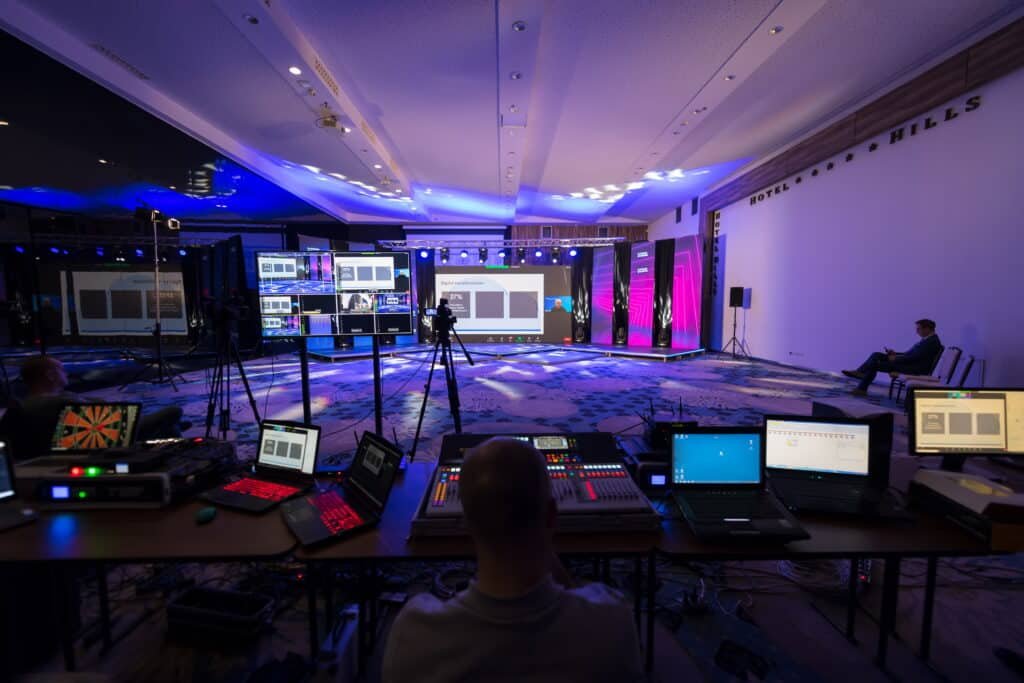Virtual events have emerged as an essential component of the structure of business and organizational interactions with their audiences in an increasingly digital world. Webinars and online conferences, as well as virtual trade show and product launches, are just the beginning. With the increasing popularity of the digital experience, the demand of producing virtual events has risen. However, what is virtual event production and how can it be used to turn around your business?
This paper is going to cover what a virtual event production means, its advantages, and the way it can make a difference to your viewers. We will also cover the main aspects of successful virtual events, the tools you require, and address the most commonly asked questions to guide you in implementing virtual event production as part of your business strategy.
What is Virtual Event Production?

What Virtual Event Production is.
Virtual event production is the process of planning, coordinating or organizing events that occur in a virtual or online platform. This can encompass all the technical (setting up platforms and live streaming) to the creative (creating engaging content and event logistics) sides.
The creation of virtual events is usually handled by departments specialized in different areas, including live streaming, content creation, audio-visual systems, interactive interaction technologies, and event marketing.
Virtual events unlike traditional events are hosted in physical facilities, thus all people around the globe can access the event, making them more user-friendly and expandable.
Why Virtual Event Production is Important
Also, virtual events can help the business to connect to the world without physically traveling to the places of interest hence saving time and costs as well. They offer live communication, the possibility to monitor the activity of attendees, and a chance to apply multiple digital instruments to improve the overall experience. Using cloud-based technologies, companies can hosting simple webinars to sophisticated conferences with numerous interactive sessions are easily hosted.
Key Components of Virtual Event Production
1. Event Planning and Strategy

The initial process of producing virtual event is to develop an effective event strategy. This involves the purpose of the event, objectives and the target audience. The strategy must also provide the key messages you wish to pass across and how you will accomplish the objectives.
Virtual planning also implies choosing a suitable virtual platform based on the needs of your event. You will need to decide whether you would live-stream your event or pre-record it or both. The format could be interactive question and answer, breakout rooms, or panel discussions depending on the nature of the event.
2. Technology Setup
A successful virtual event has to do with the right technology. Virtual event platforms like Zoom and Hopin, Airmeet or Vimeo are required to hold virtual events. These applications provide the necessary live streaming, video meeting, and on-the-fly communication features to the audience.
You should also remember audio-visual equipments, nice cameras, microphones and lights because you will want the event to look and sound professional. With good tech support, there will be no glitching event.
3. Content Creation
The virtual world concerns itself with content. The quality and relevance of your content is extremely important when you are hosting a product launch or a webinar. This includes structured presentations, recorded videos, panel discussions and interactive information that promotes interaction.
In order to be as engaging as possible, you can think about integrating different content, such as live polls, live chats, and live question-answer. Graphics, animations, and infographics are also helpful.
4. Audience Engagement
One of the greatest advantages of virtual events is engaging the audience in real-time. Interaction during the event is possible through live polling tools, question and answer sessions and chat rooms. Additionally, one can also include virtual networking like breakout rooms or face-to-face meetings to allow participants to meet and connect with speakers, sponsors, and other people.
Gamification, contests, and prizes are tools that can also be used to trigger interaction and keep your audience interested and engaged.
5. Event Promotion and Marketing
However good planning you have made on your virtual event, unless you have justifiable promotion, your event would not have been a success. Virtual event production includes event marketing to create awareness and attract people. This involves email marketing, social media advertising, paid advertising, and hiring influencers to spread the word.
One can also create a registration page and offer attendees early bird discounts or exclusivity to gain attendance.
6. Post-Events Analysis and Reporting.
Virtual event production does not end with the event. The success of the event and how it can be improved is important to post-event analysis. Measures of attendance, session attendance, and post-session surveys will help you realize whether you achieved your objectives.
Allowing participants access to recordings (on-demand or following-up email) can also contribute to the continuation of the discussion and enhance the value of your event.

Benefits of Virtual Event Production
1. Cost-Effectiveness
Virtual events conserve much money associated with traditional events such as renting the venue, food and traveling expenses. This is to make them attractive to businesses with a low budget or to businesses that need to reach many people at a lower cost.
2. Global Reach
In contrast to physical events, virtual events eliminate geographical boundaries, so you can invite people to your event regardless of their location. This international coverage can result in more brand exposure, new business collaborations and the possibility to exploit markets that you may not have thought of previously.
3. Increased Flexibility
Virtual events are more flexible, in both time and content presentation. You will have the freedom to decide when to hold your event and with appropriate platform, participants will have access to on-demand sessions or can watch recorded events when they want.
4. Data analytics and collection.
Virtual events enable companies to gather helpful information about their audience, including the demographics of the attendants, the activity, and feedback of the session. You can use this information to revise your marketing strategies and better upcoming events.

FAQs About Virtual Event Production
1. What are the most important tools required to produce virtual events?
The primary equipment needed to produce a virtual event encompasses event applications (such as Zoom, Hopin, or Airmeet), streaming applications, audio-visual devices (microphones, cameras, lighting) and engagement solutions (live polls, Q&A, chat).
2. What can I do to make my virtual event a success?
To make your technology work seamlessly, you should test it well in advance of the event, have a backup in case of technical problems, and contract an expert production team. As well, practice important meetings and observe activity during the event.
3. What sort of virtual events is possible?
Different kinds of virtual events that you can create are; Web conference, online conference, product launch, virtual trade show, workshops and virtual networking. The format may change according to your purposes and audience.
4. What do I do to keep people entertained at a virtual event?
It can be enhanced through adding interactive elements like live question and answer, polls, chat rooms, and gamification. They can also be kept interested by providing networking opportunities and exclusive content.
5. How much does it cost to produce a virtual event?
The price of producing a virtual event may fluctuate greatly based on the complexity and size of the event. Simple webinars can be quite cheap, and larger-scale virtual conferences involving multiple participants and involving interaction can have a larger budget.

Conclusion:
Production of virtual events has taken the center stage in the current business strategies. You may be holding a small webinar or a massive virtual conference, but the correct preparation, technology, and implementation can make your virtual event an extremely interactive one that produces outcomes. Knowing the main aspects of the production of the virtual event, you will be able to conclude the potential of digital interaction, expand the scope of your interest worldwide, and promote your brand. As the virtual event production continues to gain traction, this is the ideal moment to consider how production of virtual events can revolutionize your business.





